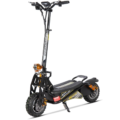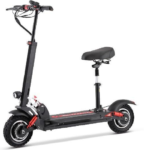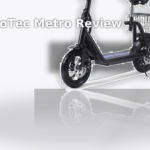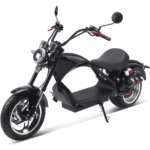- Home
- Scooters
- Electric Scooters
- MotoTec Mad
MotoTec Mad
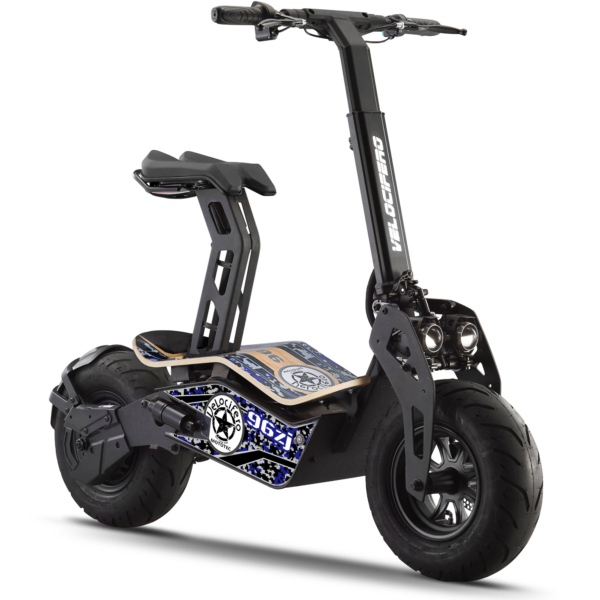

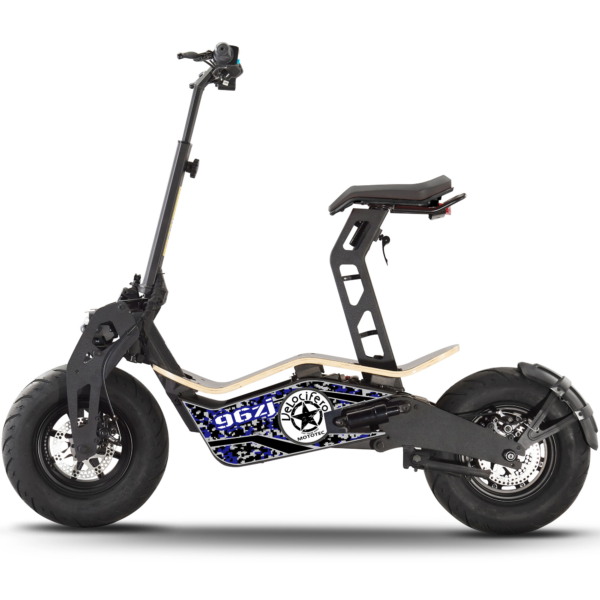
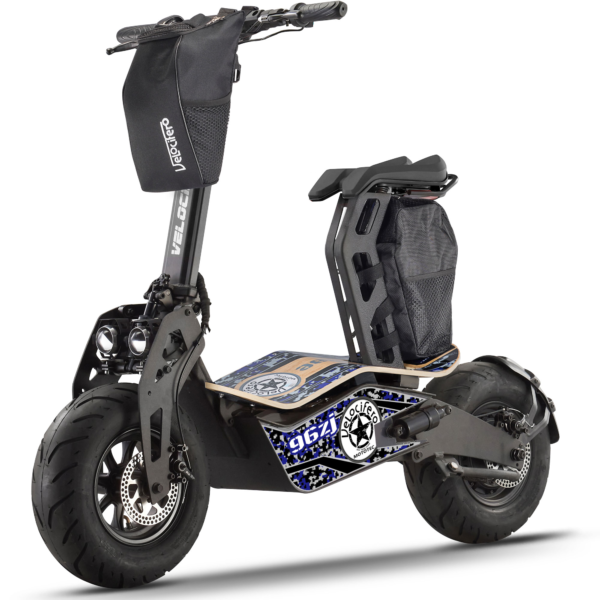
- Battery Range: 18–22 miles (29–35 km)
- Top Speed: 25 mph (40 km/h)
- Motor Power: 1600 W
- Weight Capacity: 310 lb (140.6 kg)
- Charging Time: ~4–8 h
- Scooter Weight: Not specified
PROS
- 1600 W rear hub motor
- 18–22 mi (29–35 km) range
- Single front & dual rear suspension
- Front and rear disc brakes
- Adjustable handlebar; bamboo deck
CONS
- Top speed trails others at ~25 mph
- Lead-acid battery pack
- Scooter weight not specified
- No official IP rating
- No smart/app features
Key Takeaways
- The MotoTec Mad is a heavy fat-tire electric scooter designed for urban trips and short commutes.
- It features a 1600-watt motor, disc brakes, and a bamboo deck for stability and comfort.
- The scooter has a maximum speed of 25+ mph and a range of 18-22 miles based on conditions.
- Portability is limited due to its weight of 106 lbs, but it folds for storage.
- Ideal for larger riders and those who prefer DIY maintenance, it’s not suited for rainy climates or long distances.
Table of contents
- What Is the MotoTec Mad?
- How the MotoTec Mad Works
- Key Specifications
- Design & Build Quality
- Performance Fundamentals
- Battery, Range & Efficiency
- Ride Quality & Comfort
- Braking & Safety Features
- Portability & Daily Usability
- Maintenance & Care
- Weather & Seasonal Considerations
- MotoTec Mad vs Alternatives
- Who the MotoTec Mad Is (and Isn’t) For
- FAQs
- Glossary
The MotoTec Mad is a fat-tire electric scooter with a steel frame, a seat, and a wide bamboo deck. It rides steady, it brakes hard when you need it, and it keeps the controls simple. It fits short urban trips, campus errands, and relaxed weekend loops on smooth streets. And the tall bar plus roomy stance make it friendly for bigger riders too.
What Is the MotoTec Mad?
Think mini-bike posture with stand-up scooter handling. You ride on a wide, skate-style bamboo board that sits on a tough steel chassis. A 48-volt power system feeds a 1600-watt motor through a chain. Front and rear disc brakes handle the stopping. A single front shock and twin rear shocks take the edge off bumps. Then a fold joint lets the stem drop for storage in a trunk or closet.
Top speed lands in the mid-20s mph, which is faster than most budget commuters. The 1600-watt trim sits at the top of the Mad line, so it feels punchy at low speed and calm at city pace. Range lives in the short-to-medium band and shifts with rider weight, hills, wind, and temperature. The pack uses sealed lead-acid bricks, so charge habits and storage matter more than with lithium.
How the MotoTec Mad Works
A battery, a controller, and a motor do the heavy lifting. Picture the battery as fuel, the controller as the metering brain, and the motor as the engine.
- Motor: The system runs at 48 V and delivers 1600 W. The catalog language can read like “hub,” yet the final drive is a chain, and the maintenance routine treats it that way. So plan on chain care. The feel is crisp when you roll on the throttle, and service stays simple with basic tools.
- Controller: A matched 48 V controller sends current to the motor as you twist the throttle. It meters power in small steps, so starts feel smooth and repeatable.
- Battery: Four 12 V, 12 Ah sealed lead-acid batteries sit in series for 48 V total. That gives roughly 576 Wh of energy. So the scooter feels strongest right after a full charge and softens near empty.
- Throttle and brakes: A twist grip on the right runs the drive. Two levers run the mechanical discs. The layout mirrors a bicycle, so the learning curve is short.
- Lights and horn: Dual headlights and a horn ship in the box. Use both in daylight traffic. You will get noticed more often.
Key Specifications
The table below groups the core specifications you need for daily use and setup.
General
| Item | Value |
|---|---|
| Model | MotoTec Mad (1600 W, 48 V) |
| Frame | High-tensile steel |
| Deck | Bamboo |
| Tires | Street tread (size below) |
| Suspension | Front: single shock; Rear: dual shocks |
| Brakes | Front and rear disc |
| Lights | Dual headlights |
| Horn | Yes |
| Foldable | Yes |
| Handlebar | Height adjustable |
Performance & Power
| Item | Value |
|---|---|
| Motor | 48 V, 1600 W brushless, chain final drive |
| Top speed | 25+ mph (about 45 km/h) |
| Max torque | 21 Nm |
| Rated rider weight | 310 lb (140 kg) |
Battery, Charging & Electrical
| Item | Value |
|---|---|
| Battery | 48 V, 12 Ah sealed lead-acid (4×12 V 12 Ah) |
| Energy | ~576 Wh |
| Range (rated) | 18–22 miles (30–35 km), ideal conditions |
| Charge time | 4–8 hours |
| Charge input | 110–240 V |
Build & Dimensions (include folded)
| Item | Value |
|---|---|
| Scooter weight | 106 lb (48 kg) |
| Overall length | 52.0 in (1320 mm) |
| Overall width | 12.6 in (320 mm) |
| Folded height | 22.4 in (570 mm) |
| Handlebar height | 37.4–43.1 in (950–1096 mm) |
| Seat height | 29.5–31.5 in (750–800 mm) |
| Folded size | 52.0 × 12.6 × 22.4 in (1320 × 320 × 570 mm) |
Safety & Control
| Item | Value |
|---|---|
| Brakes | Mechanical discs, front and rear |
| Lighting | Dual headlights |
| Audible | Horn |
| Wet use | No riding in rain or snow listed |
Features & Extras
| Item | Value |
|---|---|
| Accessories in box | Tool kit; seat and frame; fuse (varies by package) |
| Cruise control | Not listed |
| Final drive | Chain |
| Tire size | 135/65-8 street profile |
Warranty & Compliance
| Item | Value |
|---|---|
| Warranty | 60-day parts replacement |
| Compliance | CEC certified for California sales |
Design & Build Quality
At first glance, the Mad looks like a mini-bike. The frame uses thick tubes and plates that feel stout in the hands. Welds favor function over flash, which fits the point of this scooter. The bamboo deck spans the full width between the tires. So you can plant both feet forward for a relaxed stance at speed. Grip tape is coarse and holds shoes well in dry conditions.
The cockpit stays simple and familiar. A twist throttle sits on the right. Two brake levers mirror a bicycle. A key switch sits near the bar. The handlebar raises and lowers, and you can tweak the angle at the clamp. The seat frame bolts into the deck tray. You can remove it in a few minutes if you prefer stand-up rides. Then the stem folds down with a front clamp and knob to cut height for storage.
Fit and finish target daily use more than showroom shine. Cables run cleanly along the stem and frame with clips. The deck bolts to a steel tray, so you can reach the battery bay with hand tools. The whole thing feels planted, and it stays composed on clean pavement.
Performance Fundamentals
The MotoTec Mad steps off with a strong pull. So it clears stop signs without drama, and it merges into bike-lane traffic with a short twist. The fat rear tire adds contact patch. That helps straight-line traction on dry streets. Then the chain drive gives a direct, mechanical feel when you roll into the throttle.
Cruising feels calm at city pace. The wide tires and wheelbase damp little shakes that bother narrow-tire commuters. The single front shock trims the bite from seams and joints. The twin rear shocks help the back tire track across patched asphalt. You still need to pick lines on broken streets. The chassis sits low, and square-edged holes still hit hard if you miss them.
What about hills? Short climbs in the 7–10% range pass without fuss on a fresh charge, and lighter riders keep more speed. Long grades ask for patience. Lead-acid chemistry sags under heavy draw, so the pull fades late in the pack. Plan your route with gentle grades if you are cutting it close on range, and keep speed steady rather than spiking the throttle.
Battery, Range & Efficiency
The pack uses four 12 V, 12 Ah sealed lead-acid bricks in series. That works out to 576 Wh of stored energy. On flat ground in warm weather with a light rider, you can reach the top of the rated band. In cold weather or headwinds, the number drops. So expect a mid-teens mile day in mixed city use, then add a buffer.
Charging takes 4–8 hours. Overnight top-ups fit most routines, and this chemistry likes frequent charges. Plug in after rides, and avoid deep drains. Keep the scooter in the shade while charging on hot days. That small habit gives the pack an easier life. And keep the charge port cap clean, since grit there can cause weird cut-outs.
Pressure and load change miles too. Keep tire pressure inside the sidewall range and check it weekly. Plus, remove the seat and bags when you do not need them. Ride at a steady pace, and roll on the throttle instead of snapping it open. For example, a gentle launch across a week can save you a few miles of energy.
Ride Quality & Comfort
The 135/65-8 street tires feel planted. The wide contact patch holds a line across tar snakes and patched asphalt. Grip stays predictable on clean, dry streets. At or near the marked pressure, the sidewalls resist pinch flats on potholes. They still pass small vibrations to the deck. So the shocks matter.
The front shock takes the sting off sharp seams and alley lips. The twin rear shocks soften bumps that would toss a rigid deck. Large holes still come through. So pick a clean path and bend your knees on rough blocks. The tall stem can show a touch of flex for heavier riders at the highest height setting under hard braking. Drop one notch if you want the tightest bar feel.
The bamboo deck earns real points for size. You can stand shoulder-width with toes forward. That reduces foot fatigue on longer blocks. It also lets you shift weight more naturally while braking, since you can brace over the front wheel.
Braking & Safety Features
Twin mechanical discs bring firm, linear bite. Start with the rear lever to settle the chassis, and squeeze the front as you straighten the bars. Practice hard stops in a dry, empty lot. You will feel the point just before lockup. Then you will know exactly how the levers respond when a car backs out of a driveway.
Lights help even in daylight. Keep the headlights on in bright sun. Drivers notice the flicker at intersections. The horn is there for close calls at parking-lot speeds. The scooter lists no formal IP rating, and the manual advises no rain or snow use. So keep rides dry, and wipe the bike down if it picks up splash or winter street salt.
Portability & Daily Usability
At 106 lb (48 kg), the MotoTec Mad is heavy. Carrying it up stairs is not fun. The fold helps with trunk loading and hallway storage. The stem drops to 22.4 in (570 mm) in folded height. Length stays 52 in (1320 mm), so you still need floor space. The box ships near 150 lb, which is a two-person lift for most people.
Daily habits make life easier. Roll into elevators instead of carrying. Park on level ground and stow the stand before moving. For security, pair a heavy U-lock on the frame with a stout chain through the rear wheel. Avoid locking only the deck. The bamboo board will not stop a saw. Tie off to steel whenever you can, and pick a bright, busy spot.
Maintenance & Care
After each ride
- Wipe the frame and deck, then check for loose bolts.
- Spin wheels and listen for rotor rub.
- Check tire pressure and scan the tread for cuts.
- Top off the battery while it is still warm from the ride.
Weekly
- Inspect the chain for slack and grit.
- Clean and lube the chain, then wipe off the extra.
- Check visible fasteners on the stem clamp, deck tray, and seat frame.
- Spin both wheels and listen for bearing noise.
Monthly
- Check pad wear and rotor surface.
- Snug the stem clamp bolts and fold-knob hardware.
- Inspect shock mounts for play.
- Look for cable rub or pinch points near the fold joint.
Battery storage
- Store fully charged in a cool, dry space.
- Top up every 2–4 weeks while parked.
- Avoid deep discharges.
- Unplug the charger when the cycle completes.
Chain tensioning
Chain care is part of normal service. Keep slack inside the spec band, and recheck after the first few rides on a fresh chain. A snug chain reduces lash when you roll into the throttle. It also cuts rattle at cruise. If you hear clatter at the rear sprocket, stop, then measure slack before the next ride.
Weather & Seasonal Considerations
Ride dry. Water lengthens stopping distances, and wet grit chews on chains and rotors. So keep the scooter out of rain, and dry the chain before storage. If you get caught in a splash, wipe down the frame and deck, and clear the brake rotors with a clean rag.
Cold weather trims range. Voltage sags earlier and grease thickens. Plan shorter rides and charge sooner. Heat brings a different set of problems. Give the charger some airflow, park out of direct sun, and let the scooter cool before charging after a long, hot run.
MotoTec Mad vs Alternatives
Versus slim commuters
The Mad wins on deck space, tire width, and a planted feel. It loses on weight and stairs. It also trades range per pound for stability and a steel frame. So it fits ground-level storage and short trips.
Versus mid-power lithium scooters
The Mad brings a simple drive, thick steel, and big tires. Many lithium models charge faster and weigh less. Those scooters often add flashy displays and phone apps. They also raise price and complexity. Pick your priority first, then match the scooter to your route. If you want a lighter commuter with a lithium pack and a calm ride, check the NIU KQi-200P.
Versus off-road trail rigs
The Mad likes smooth pavement and hardpack. The street profile tires reward clean lines and steady speed. True trail rigs add knobby tires, more ground clearance, and stronger hydraulic brakes. They climb loose hills and descend sketchy sections better.
Inside the MotoTec family
The Raven runs a lithium pack and higher system voltage, so it pulls harder and ranges longer. The MotoTec Mad leans into value and a tough steel build. Pick the Mad if your rides are short and you want wide-tire stability with simple service. For a simpler stand-up option from the same brand, see the MotoTec Metro. It keeps the stand-up vibe with a straightforward setup.
Who the MotoTec Mad Is (and Isn’t) For
Great for
- Urban riders who want a planted stance and wide tires.
- Students with ground-level storage or elevator access.
- Short daily commutes under 8 miles round trip.
- Taller riders who need bar height and a roomy deck.
- Owners who like basic tools and DIY service.
Not ideal for
- Walk-ups with many stairs.
- Rainy climates where wet rides are common.
- Long, daily runs that call for fast lithium charging.
- Riders who carry a scooter on buses often.
FAQs
How fast does it go?
Top speed sits at 25+ mph on the 1600-watt trim, which puts it in the mid-speed city class.
What range should I expect day to day?
Plan for mid-teens miles in mixed city use. In warm weather on flat ground, light riders reach the top of the rated band.
Can I ride it in the rain?
No. There is no listed IP rating, and the guidance says no rain or snow use. Keep rides dry.
What does this MotoTec Mad overview cover?
You get core specs, design notes, ride feel, care tips, and a plain comparison to nearby classes.
Is the motor a hub or chain drive?
Treat it as a chain-driven setup. The maintenance routine covers chain service, and the final drive listing is chain.
What is the weight limit?
The rating shows 310 lb. Heavier riders should expect shorter range and slower hill starts.
What is the warranty?
The coverage lists 60-day parts replacement for this model.
Glossary
- Ah (amp-hours): Capacity measure. Higher numbers store more charge.
- Wh (watt-hours): Energy measure. Volts × amp-hours.
- Controller: The box that meters battery power to the motor.
- Lead-acid: Battery chemistry that is heavy and low-cost. It likes frequent top-ups.
- Brushless motor: Motor type that uses electronics for smooth phase switching.
- Final drive: The last stage from motor to wheel, such as a chain.
- Rotor: The steel disc that the brake caliper squeezes.
- Pad bite: The initial grip you feel at the lever.
- Stem flex: Small movement at the handlebar post under load.
- Wheelbase: Distance between the axle centers.
- PSI: Tire pressure unit printed on the tire sidewall.
- IP rating: Dust and water protection code. None is listed here.
- SLA: Short for sealed lead-acid, the pack chemistry used on this model.
- CEC: California Energy Commission sales compliance tag.
- Torque: Rotational force from the motor.
Specifications
General
| Model The Model specifies the exact version or name of the scooter. It helps identify its unique design, features, and specifications within the manufacturer’s product line. Knowing the model makes it easier to compare options, find compatible accessories, or look up support information. | Mad |
| Brand The Brand identifies the manufacturer or company that designs and produces the scooter. A trusted brand is a sign of quality, reliability, and good customer support. Well-known brands often have higher standards for safety, performance, and after-sales service, giving you more confidence in your purchase. | MotoTec |
| Release Date The Release Date indicates when the scooter model was officially launched on the market. This helps you know how current the design, technology, and features are. A newer release date often means updated components, improved performance, and the latest safety or smart features. | 18 November 2025 |
| Recommended Age Recommended Age indicates the minimum age range that the scooter is designed for, based on safety, size, and ease of use. Following the recommended age helps ensure that riders can handle the scooter’s speed, weight, and controls comfortably and safely. Always check local laws and use protective gear, especially for younger riders. | 13+ |
Performance & Power
| Motor Power (Wattage) What it means: The motor power, measured in watts (W), shows how strong the scooter’s electric motor is. Why it matters: Higher wattage usually means better acceleration, more torque, and improved performance on hills or rough terrain. For example, a 250W motor is good for flat city roads and light riders, while a 500W or 1000W motor provides more power for faster speeds or climbing steep inclines. | Rear hub motor, 1600 W (48 V) |
| Top Speed The Top Speed indicates the maximum speed that the scooter can reach under optimal conditions. It’s usually measured on level ground with a fully charged battery and an average rider weight. A higher top speed allows you to travel longer distances faster, but always ensure you ride within legal speed limits and your personal comfort zone for safety. | 25 mph (40 km/h) |
| Battery Capacity Battery Capacity refers to the total amount of energy the scooter’s battery can store, usually measured in ampere-hours (Ah) or watt-hours (Wh). A higher battery capacity means you can ride longer distances on a single charge, reducing the need for frequent recharging. Keep in mind that actual range can vary depending on rider weight, terrain, speed, and weather conditions. | 48 V 12 Ah (576 Wh) Lead-acid (4×12 V 12 Ah) |
| Estimated Range per Charge The Estimated Range per Charge indicates the average distance the scooter can travel on a single full battery charge. This range is calculated under optimal conditions, such as flat terrain, moderate speed, and average rider weight. Real-world range may vary depending on riding style, terrain, weather, and load. A longer range means fewer recharges and greater freedom for longer trips. | 18–22 miles (29–35 km) |
| Hill Climb Ability Hill Climb Ability describes the maximum incline or slope that the scooter can handle while maintaining stable performance. It’s typically expressed as a percentage or in degrees. A higher hill climb rating means the scooter can tackle steeper hills without losing too much speed or power. Actual climbing performance may vary based on rider weight, battery charge, and terrain conditions. | Not specified |
| Drive System The Drive System refers to how power from the motor is delivered to the wheels. Electric scooters typically use either a hub motor (directly integrated into the wheel) or a chain/belt drive system. A high-quality drive system ensures smooth acceleration, efficient power transfer, and low maintenance. The choice of drive system affects performance, noise level, and overall ride experience. | Rear hub (RWD) |
Charging & Electrical
| Charging Time Charging Time indicates how long it takes to fully recharge the scooter’s battery from empty to 100% using the standard charger provided. Faster charging means less downtime and more time on the road. Actual charging time may vary slightly depending on battery capacity, charger output, and environmental conditions. | Approx. 4–8 hours |
| Battery Type Battery Type refers to the specific technology used in the scooter’s battery, which affects performance, lifespan, weight, and charging time. Most modern electric scooters use high-quality lithium-ion (Li-ion) batteries because they offer a good balance of energy density, durability, and low maintenance. A reliable battery type ensures consistent power delivery and longer riding ranges. | Sealed lead-acid battery |
| Removable Battery A Removable Battery means the battery pack can be easily detached from the scooter for convenient charging and replacement. This feature allows you to charge the battery separately, swap it with a spare for extended range, or securely store it indoors in extreme weather. Removable batteries add flexibility and make it easier to keep your scooter powered up wherever you are. | Non-removable internal battery |
| Regenerative Braking Regenerative Braking is an energy-saving feature that converts some of the energy normally lost during braking back into battery power. When you slow down or brake, the motor works in reverse to generate electricity, which helps extend the scooter’s range and improves overall efficiency. This system also reduces wear on traditional brake components, leading to lower maintenance over time. | No |
| Lighting Lighting refers to the built-in front and rear lights that enhance visibility and safety when riding in low-light conditions or at night. Good lighting helps you see the road ahead and ensures that other road users can see you. Many scooters include LED headlights, taillights, and sometimes brake lights or side reflectors for added safety and compliance with local traffic regulations. | Headlight; rear light; horn |
Build & Dimensions
| Scooter Weight Scooter Weight refers to the total weight of the scooter when fully assembled, including the battery. This affects how easy it is to carry, lift, and store the scooter when not in use. A lighter scooter is more portable and convenient for commuting, especially if you need to carry it upstairs or onto public transport. Keep in mind that a sturdy frame and quality components may add to the weight but also contribute to better durability and ride stability. | Not specified |
| Maximum Rider Weight Maximum Rider Weight indicates the highest rider weight that the scooter is designed to safely support while maintaining optimal performance and stability. Staying within this limit helps ensure reliable acceleration, braking, and climbing ability, and it protects the frame, suspension, and motor from excessive strain. Exceeding the recommended limit may reduce performance and increase wear on components. | 310 lb (140.6 kg) |
| Deck Size Deck Size refers to the dimensions of the scooter’s standing platform. A wider and longer deck provides more foot space, allowing you to stand comfortably and adjust your stance while riding. A well-sized deck improves balance and stability, especially on longer rides or at higher speeds. Compact decks, on the other hand, help keep the scooter lightweight and portable. | Wide bamboo deck; seated scooter geometry |
| Handlebar Height Handlebar Height refers to the distance from the deck to the handlebars, which affects your riding posture and comfort. An appropriate handlebar height helps you maintain good balance, reduces strain on your back and arms, and makes steering more comfortable. Some scooters have adjustable handlebars to fit riders of different heights, while others have a fixed height for a streamlined design. | Adjustable |
| Folding Mechanism The Folding Mechanism describes how easily and securely the scooter can be folded for carrying and storage. A well-designed folding system lets you quickly collapse the scooter into a compact size, making it convenient to transport on public transit, store under a desk, or fit into a car trunk. Look for sturdy latches and safety locks to ensure the scooter stays firmly in place when folded or unfolded. | Folding frame |
| Dimensions Folded Dimensions indicate the size of the scooter when it’s fully folded. This measurement shows how much space the scooter will take up when stored or carried, making it easier to check if it will fit in your car trunk, under a desk, or in a closet. Compact folded dimensions are ideal for commuters who need to bring their scooter on public transport or store it in tight spaces. | Not specified (folded/unfolded) |
| Material Material refers to the primary construction materials used for the scooter’s frame and key components. High-quality materials like aircraft-grade aluminum, reinforced steel, or durable composites provide strength, stability, and a lighter overall weight. A sturdy material ensures the scooter can handle daily wear and tear while maintaining safety and performance. | High-tensile steel |
Safety & Control
| Brake Type(s) Brake Type(s) describe the braking systems the scooter uses to help you slow down or stop safely. Common brake types include mechanical brakes (like drum or disc brakes), electronic brakes, and foot brakes. Many scooters combine multiple braking systems for added safety and shorter stopping distances. The type and quality of brakes affect your control, especially when riding at higher speeds or on slopes. | Front & rear disc brakes |
| Suspension Suspension refers to the system that absorbs shocks and vibrations while riding, providing a smoother and more comfortable ride over uneven or rough surfaces. Scooters may have front suspension, rear suspension, or dual suspension for better shock absorption and stability. Good suspension helps reduce rider fatigue and improves control, especially when riding on bumpy roads or off-road paths. | Single front, dual rear suspension |
| Tire Type Tire Type refers to the kind of tires the scooter uses, which directly affects ride comfort, traction, and maintenance. Common types include solid (airless) tires, pneumatic (air-filled) tires, or hybrid options. Pneumatic tires offer better shock absorption and a smoother ride on rough surfaces, while solid tires are puncture-proof and require less upkeep. The right tire type helps ensure safe handling and a comfortable ride in different conditions. | 135/65-8 street tires |
| Tire Size Tire Size indicates the diameter and width of the scooter’s tires, which affect ride comfort, stability, and how well the scooter handles different terrains. Larger tires generally offer better shock absorption and a smoother ride over bumps and rough surfaces, while smaller tires keep the scooter lighter and more portable. Choosing the right tire size helps ensure a balance between agility and comfort. | 8-inch rim |
| Kickstand The Kickstand is a built-in stand that allows you to park your scooter upright when it’s not in use. A sturdy kickstand keeps the scooter stable and prevents it from tipping over, protecting it from scratches and damage. It also makes storing and accessing your scooter more convenient, whether you’re at home, work, or on the go. | Side kickstand |
| Water Resistance Rating Water Resistance Rating indicates how well the scooter is protected against water and moisture, usually shown as an IP (Ingress Protection) rating. This rating helps you understand whether the scooter can handle light rain, splashes, or wet roads without damage. While most scooters are not fully waterproof, a good water resistance rating adds peace of mind when riding in changing weather conditions. Always avoid deep puddles or submerging the scooter to protect its electrical components. | Not specified |
Features & Extras
| Display/Console The Display (or Console) shows important real-time information about your ride, helping you monitor your scooter’s status at a glance. Typical displays show speed, battery level, distance traveled, and riding mode. Some models also include additional features like Bluetooth connectivity, app integration, or backlighting for better visibility at night. A clear and easy-to-read display enhances safety and convenience on every trip. | Basic display/indicators (details not specified) |
| Ride Modes Ride Modes refer to the different speed and power settings you can choose to match your riding style or road conditions. Common modes include eco for maximum range and energy efficiency, standard for everyday balance, and sport or turbo for higher speed and stronger acceleration. Switching between ride modes allows you to customize performance, conserve battery, and ride safely in various environments. | Not specified |
| Smart App Connectivity Smart App Connectivity lets you pair your scooter with a dedicated mobile app via Bluetooth. Using the app, you can monitor real-time ride stats like speed, battery level, and range, adjust settings such as ride modes or cruise control, lock the scooter for added security, and sometimes receive firmware updates. This feature adds convenience and allows you to personalize your riding experience right from your smartphone. | No app |
| Anti-Theft System The Anti-Theft System helps protect your scooter from unauthorized use or theft. This feature can include built-in alarms, electronic motor locks, GPS tracking, or remote locking through a mobile app. A good anti-theft system provides peace of mind when parking your scooter in public spaces, adding an extra layer of security to safeguard your investment. | None stated |
| Cruise Control Cruise Control allows you to maintain a steady speed without continuously holding the throttle. This feature makes longer rides more comfortable by reducing hand fatigue and providing a smoother, more relaxed riding experience — especially on flat, open roads or bike lanes. For safety, cruise control can usually be easily activated or deactivated while riding. | No |
| Accessories Included Accessories Included lists the additional items that come with the scooter to enhance your riding experience and convenience. Common accessories may include a charger, kickstand, bell, lights, phone holder, or carrying strap. These extras add value by making your scooter safer, easier to use, and ready to ride straight out of the box. | Scooter, charger, tools, manual |
Warranty & Compliance
| Warranty Period The Warranty Period indicates how long the manufacturer guarantees the scooter against defects in materials and workmanship under normal use. A good warranty provides peace of mind, showing the brand’s confidence in its product quality. Always check what parts are covered, such as the frame, battery, and motor, and follow the maintenance guidelines to keep your warranty valid. | 60 days parts replacement (USA) |
| Certifications Certifications confirm that the scooter meets specific safety, quality, and environmental standards set by recognized organizations or regulatory bodies. Common certifications may include CE, RoHS, UL, or other local compliance marks, depending on your region. These certifications ensure that the scooter is manufactured to high standards and is safe and legal to use in your country. | Region-dependent |


